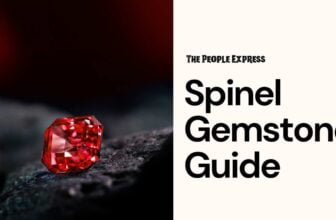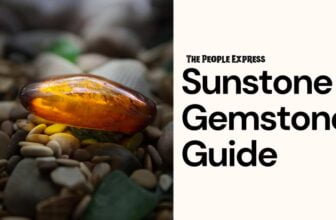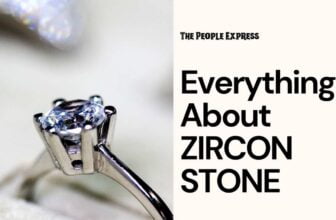Green is among the most sought-after colors for gemstones and has always been an important color in the gemstone world. It is a sophisticated color that adds a touch of elegance to any outfit. Green symbolizes life and renewal, as well as freshness, nature and energy. It is the most soothing color on the spectrum and we are naturally drawn to it. learn about List of Green Gemstones Guide.
List of Green Gemstones Guide
Although emeralds may be the most well-known green gemstone, there are over 100 types of green gemstones that can be used in jewellery. These range in shades, prices and features, and it can be difficult to choose the right stone to suit your purposes. Here we list the top 16 green gemstones that are stunning in jewellery.
Green Diamond
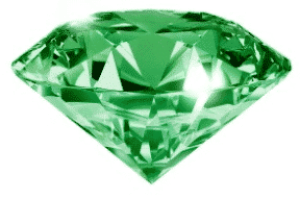
Features:
- An exclusive gemstone
- Extremely rare
- Very expensive
- Synthetic varieties available
Green diamonds are extremely rare. While most colored diamonds get their color from the presence of trace elements, green diamonds are quite unique in this respect. They receive their coloring from natural irradiation that occurs over thousands of years. Yes, radiation is dangerous, but green diamonds are not radioactive and are safe to wear.
Green diamonds are very expensive, but not as much as red or pink diamonds. They are found ranging in shades from faint to deep green, sometimes with secondary tones of yellow, brown or blue. Because they are so expensive, synthetic (man-made) green diamonds offer a more affordable option.
Green Sapphire
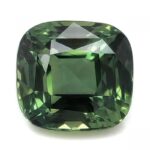
Features:
- Rare
- Highly durable
- Commonly heat treated
- Synthetic varieties available
Until recently, green sapphires were not considered very desirable, but they are now increasing in popularity. Green sapphires are quite rare and get their color from the presence of iron. Because blue is the desirable sapphire color, it can be difficult to find green sapphire jewellery.
These gemstones come in shades varying from faint green to dark green, with secondary hints of blue or yellow. Because of sapphire’s excellent gemstone qualities, such as high durability (Mohs 9), brilliance and beauty, green sapphires are a good choice for all types of rings. Most green sapphires are heat treated, which is a common industry standard.
Emerald
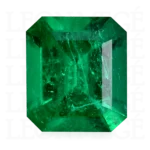
Features:
- Most well-known green stone
- Often heavily included
- Commonly treated
- Not highly durable
- A beryl variety
The most popular green gemstone of all, emeralds have been used since antiquity. The famous Egyptian queen Cleopatra was known for wearing emeralds. Emeralds were even used in burial rituals, as mummies have been found buried with emeralds.
Emeralds are a member of the illustrious beryl family of gemstones. When purchasing an emerald, the most important factor is color. After all, an emerald is nothing if not green. The more intense and vivid the color, the more valuable the stone. Most emeralds contain inclusions, often moss-like threads nicknamed ‘jardin’ for the French word garden. These are very common and eye-clean emeralds are incredibly rare.
Emeralds are fairly durable stones (7.5 to 8 Mohs) but the inclusions can cause the stone to weaken and chip when exposed to rough wear. They are commonly treated and fracture-filled to enhance color and stability. Emeralds are ideal for all types of jewellery but extra care must be taken if chosen for an engagement ring.
Jade
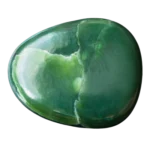
Features:
- Tough and compact
- Medium hardness
- Rarely faceted
- Highly valued in Asian countries
- Waxy to vitreous luster
The word jade is nearly a synonym of green. Jade has been valued and used since ancient times, especially in China where jade usage can be traced back to over 7000 years ago! Jade comes in two varieties: jadeite and nephrite.
Jadeite is considered more valuable and of better quality, while nephrite is more abundant and less expensive. Jade is fairly soft (6 Mohs) but very tough due to its compact composition. Most jade is often cut into cabochons or various special smooth cuts or carved. Faceting jade is less common but can give the gemstone an added brilliance. Jade has an attractive waxy luster that makes you want to reach out and touch the gemstone.
Green Agate

Features:
- Commonly included
- Vitreous luster
- Often enhanced
- Medium hardness
Agate is found in a variety of colors, with green being one of the more rarer varieties. It is generally banded or found with dendritic inclusions. Unicolor green gemstones are almost always dyed to achieve the color. Agate is smooth with a vitreous luster, and is generally translucent to opaque.
They are commonly cut into cabochons but sometimes faceted for more depth and light reflection. Agates have very good durability (7 Mohs) and are suitable for all types of jewellery. Green agate is a fairly affordable gemstone although the quality of the setting and workmanship involved can hike the price of the overall piece.
Tsavorite Garnet

Features:
- Relatively new gemstone
- Very Rare
- Popular and sought-after
- Relatively expensive
- Good durability
- Good substitute for emerald
Tsavorite (a.k.a. tsavolite) is a new gemstone in the jewellery market. It is a variety of the green grossular garnet and gets its striking green color from trace amounts of vanadium or chromium present during its formation.
Tsavorite is one of the most popular of the garnet varieties and due to its rarity, it is quite valuable. Tsavorite is a very good substitute for emeralds, as it is more durable (7 to 7.5 Mohs), less expensive and equally beautiful and brilliant. What’s more, unlike emeralds, tsavorites are rarely (if ever) treated and are a natural gem. They have also not yet been synthesized.
Tsavorite gemstones occur in vivid green shades and are generally eye-clean stones of excellent transparency. They are almost always faceted to enhance their brilliance. Most tsavorite is found in up to 1 carat pieces with stones over 2 carats being rare.
Demantoid Garnet

Features:
- Most valuable garnet type
- Found in small sizes
- Distinctive inclusions
- Good brilliance
Another member of the garnet family, demantoids belong to the andradite variety. Demantoids are the most valuable type of garnets and are also very rare. Most demantoid gemstones come in sizes under 2 carats so finding a large demantoid stone is difficult.
Demantoids occur in colors ranging from faint to vivid emerald green. Some have secondary colors of yellow or brown, which are less desirable. Vivid green demantoids, which primarily come from Russia, are the most valuable. Some demantoids contain rare horsetail shaped inclusions, which are not found in other gems.
These inclusions add value to the stone, making demantoids one of the very few gemstones that gain value from its impurities. Demantoids are highly brilliant gemstones and are durable enough for regular use.
Peridot
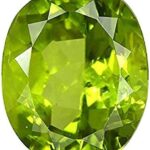
Features:
- Idiochromatic
- Good durability
- Reasonably priced
- Nicknamed the volcanic gemstone
Peridot is an idiochromatic stone meaning that it is only found in one color. It comes in shades of green, often with yellowish tones. Peridot is one of only two stones (the other being diamonds) that are formed deep within the mantle of the earth and come to the surface through violent geological activity. This is why it is also known as the volcanic gemstone. Peridot is durable enough for regular use (6.5 to 7 Mohs) but ideally should be mounted in protective settings, such as bezel, when used in rings. Peridot can be cut into all standard gems shapes, such as ovals, marquise, rounds, squares and trilliants. These shapes bring out the brilliance of the stone. Most peridot is eye-clean but can sometimes contain lillypad-like inclusions or little black spots, visible under magnification.
Alexandrite
Features:
- Color-changing stone
- Very expensive
- Rare
- Synthetic varieties common
- Highly durable
Alexandrite is a color-changing stone, known for being an ‘emerald by day and a ruby by night’. It is valued for its ability to change color from green to red based on the light source it is viewed under. Because alexandrite is very expensive and rare, the majority of alexandrites on the market are lab-created versions. On a side note, lab-created doesn’t mean fake. They are identical to natural alexandrites with the main difference being that they were created using science and technology.
Alexandrite is a hard stone (8.5 Mohs) and has excellent durability and toughness. It can be used in all types of jewellery and worn every day.
Amazonite

Features:
- Rare
- Named after the Amazon River
- Fairly hard (Mohs 6 to 6.5)
- Translucent to opaque
- Vitreous luster
This gemstone presumably gets its name from the Amazon Rainforest even though there are no amazonite deposits in that area. It comes in shades of light green to a blue-green color, but the most desirable variety is a deep, leaf-green.
Amazonite often contains white streaks or lines, forming random patterns that add character and depth to the stone. These beautiful gemstones are not generally treated or enhanced in any way. They are abundantly found and are reasonably priced.
Green Tourmaline – a.k.a. Verdalite
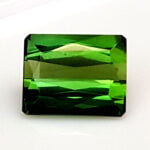
Features:
- Popular green gemstone
- Valuable color – mint green
- Very good durability
- Vitreous luster
- Brilliant
Tourmaline comes in all colors of the rainbow, with the green variety known as verdalite. Green tourmaline is a very popular gemstone and is found in all shades of green, with mint green being the most valuable. Tourmalines contain no cleavage and is quite hard (7 to 7.5 Mohs) making it a durable gemstone. Generally, green tourmalines contain little to no impurities, but those with inclusions are weaker and more prone to damage.
Green tourmalines have a vitreous luster and interact beautifully with light. When used in jewellery, green tourmalines are often faceted to maximize the reflection of light. While most tourmalines are heat treated, this is not common for green varieties.
Aventurine

Features:
- A type of quartz
- Displays aventurescence
- Medium durability
- Often opaque
Aventurine is a variety of the common quartz family. It is commonly green but can also be found in other colors. It has beautiful colors from light to dark forest green. Aventurine has a glitter effect across its surface that comes from the small flaky impurities present in the stone, known as aventurescence. This is a desirable quality of the gemstone and adds to its beauty.
Although of medium hardness (6.5 to 7 Mohs) aventurine is a tough gemstone due to its compact structure. It has a vitreous to waxy luster and is often translucent to opaque. Aventurine is mostly cut into cabochons and is classified as a minor gemstone. Aventurine can fit all styles of jewellery, such as bohemian, vintage and contemporary designs, depending on the type of setting it is paired with.
Green Labradorite

Features:
- Displays labradorescence
- Opaque varieties preferred
- Low hardness
- Fairly durable
- Affordable
Labradorite is a beautiful gemstone that often has distinct iridescence (known as labradorescence and displays flashes of color. Some labradorite displays the entire spectrum of colors while others are more subdued. Opaque varieties of labradorite are more desirable as they have labradorescence, whereas rare, transparent labradorite does not display this.
Labradorite is a plagioclase feldspar and displays its distinct labradorescence due to the way in which the rock is formed with the impurities within it. Ranking at 6 to 6.5 on the Mohs scale, it is not very scratch resistant but is a fairly tough stone. It is used in various styles of jewellery, but is particularly beautiful in bohemian and gypsy designs.
Bloodstone – a.k.a. Heliotrope and Blood Jasper
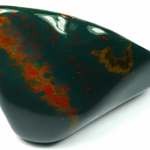
Features:
- Red/brown spots across surface
- Medium hardness
- Historically significant
- Affordable
Bloodstone derives its name from the red and brown spots that dot its surface, like blood spots. Apart from this morbid association, bloodstones are beautiful gemstones that have been used since ancient times.
Bloodstones are dark green to bluish-green gemstones of the chalcedony family and have a hardness of 6.5 to7. They are normally cut en cabochon but may sometimes be faceted. They are also ideal for carvings. Due to its hardness and toughness, bloodstone can be made into any type of jewellery, from delicate pieces to statement items. They are especially popular as a gemstone for men’s rings.
Bloodstones are usually not treated or enhanced in anyway and the color is natural. They are also very affordable making them a perfect gemstone to add to any jewellery collection.
Malachite
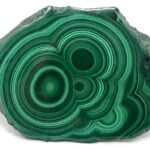
Features:
- Abundant
- Affordable
- Often displays banding and eyes
- Very soft
Malachite is known for its bright green color and interesting banding and eyes. The inclusions and intergrowths of malachite with other minerals and elements create beautiful and intriguing patterns. Malachite is a fairly abundant and are reasonably priced. However, high-quality malachite gemstones with unusual patterns or chatoyancy will command higher prices.
Malachite is a very soft gemstone (3.4 to 4) and has perfect cleavage. As a result, if exposed to rough wear and knocks, malachite can easily be damaged. It also does not handle heat or chemicals well. However, due to its stunning patterns and relative affordability, malachite is a popular gemstone, especially for statement pieces.
Green Topaz
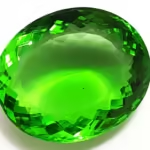
Features:
- Very brilliant
- High durability
- Often transparent
- Not a common color
Topaz is naturally colorless but gets its colors from the presence of trace elements such as chromium. Green topaz is generally very light in color with a vitreous luster. However, it is not a very popular topaz color.
Green topaz is quite brilliant and is often faceted to bring out this brilliance. Green topaz, like all topaz varieties, is an ideal gemstone for jewellery because it is durable (8 Mohs) and affordable. It is often transparent and rarely contains visible inclusions. Green topaz can be used in all types of jewellery, from bracelets and rings to earrings and pendants.
Other Notable Green Gemstones
There are many green gemstones in use in the jewellery world. Here are a few that didn’t make our top 16 list for one reason or another.
- Green Zircon– Zircon is a natural gemstone, not to be confused with cubic zirconia. It is highly brilliant and fiery and is quite rare. Natural zircon is the oldest mineral found on earth.
- Green Pearl – These are a variety of black pearls. They are known for displaying an iridescent green sheen against a dark body tone.
- Green Fluorite– This gemstone is highly valued in crystal healing. It is a very popular mineral and has bright, vivid hues.
- Prasiolite– Often called green amethyst, prasiolite is produced by heating or irradiating natural amethyst. It is not a naturally colored gemstone.
- Green Apatite– This is a rarer apatite color and comes in a variety of shades. Green apatite is lustrous and beautiful. However, most apatite stones have visible inclusions.
Green Gemstones and Metals
Green gemstones go well with all metal colors, but the metal color can affect the style of the jewellery. For example, white metals such as platinum, silver or white gold give a contemporary look to green gemstones while rose gold offers a unique, vintage look. Green gemstones set in yellow gold has a very attractive appearance. The color theory behind this is that green and yellow create an analogous color combination. This forms a relaxing and immediately likeable impression.
Green Gemstones and Skin Tone
Certain colors compliment certain skin tones better than others. There are three main types of skin tone – warm, neutral and cool. If you aren’t sure what your skin tone is, read our article on skin tones.
Green gemstones are particularly flattering against warm skin tones and can bring out the blush, earthy undertones of the skin. But this of course is not a hard and fast rule. If the gemstone looks good on you then that’s all that matters.
Where to Shop
Because green is a popular gemstone color, you will have many options even at a brick and mortar store. Most physical stores commonly stock emeralds and peridots, among others. However, if you take your search online, even the harder to find green gemstones will be accessible to you.
Conclusion
When shopping for gemstones, always purchase from a reputable and licensed jeweler and check the origin of the stone. Ask about what treatments, if any, have been conducted on the stone and where applicable, request a certificate of authenticity. Always take some time to check the genuineness and value of the item, especially if the gemstone you are eyeing is expensive.
Table of Contents
Toggle



